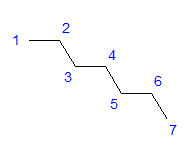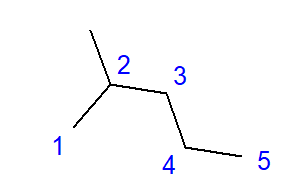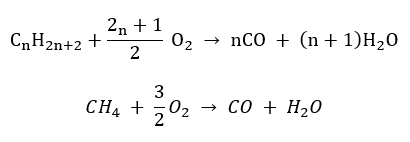In terms of chemical structure, alkanes belong to the group of hydrocarbons. These compounds contain only two types of atoms: carbon and hydrogen. They are composed of the base carbon framework linked with hydrogen atoms. Alkanes have only single bonds, which is why they are called saturated hydrocarbons.

Homologous series
Arranged by the growing amount of hydrogen atoms in their structure, alkane representatives form a homologous series. It begins with methane, containing one atom of carbon, and ends with decane with nine atoms of carbon. The names of alkanes come from the amount of carbon atoms that exist in the structure and are defined with Greek or Latin numerals as well as the characteristic -ane ending, as with heptane, nonane, etc.
The general formula for alkanes is the following: , where ‘n’ stands for the carbon (C) number present in the chain and ‘H’ represents the atoms of hydrogen.
| The number of carbon atoms present in the chain | Alkane formula | Alkane name |
| 1 | CH4 | Methane |
| 2 | C2H6 | Ethane |
| 3 | C3H8 | Propane |
| 4 | C4H10 | Butane |
| 5 | C5H12 | Pentane |
| 6 | C6H14 | Hexane |
| 7 | C7H16 | Heptane |
| 8 | C8H18 | Octane |
| 9 | C9H20 | Nonane |
| 10 | C10H22 | Decane |
Types of saturated hydrocarbons
In terms of chain structure, we distinguish the following types of alkanes:
-
Linear (paraffin) alkanes

Fig. 1 Structural formula of heptane
All carbon atoms show the sp3 hybridisation. Due to a tetragonal angle between the bonds, a zigzag-shaped arrangement of carbon atoms is required. Molecules may take various arrangements, as free rotation is possible around a single bond between carbon atoms. The higher the carbon number in the structure, the more varied the chain shapes may be.
-
Isoalkanes: branched saturated hydrocarbons
The formation of branched hydrocarbons is the effect of linking between a carbon atom and more than two other carbon atoms. A branch is formed at the point of such a link. Branched hydrocarbons are linear hydrocarbon isomers.

Fig. 2 Structural formula for 2-methylpentane
The formula for 2-methylpentane shown in Fig. 2 has a total of six carbon atoms and is a hexane isomer. The name ‘2-methylpentane’ means that the pentane chain has a linked methyl group at the position of the second carbon atom. The number of possible structural isomers grows along with the growing carbon number. To give an example, hexane can have a structure of 5 different isomers, octane has 18 such possibilities, and hexane as many as 75.
-
Cyclic hydrocarbons: cycloalkanes, alicyclic hydrocarbons
It is possible to close the chain structure while forming rings composed of repeating –CH2– elements. The names are based on the name of the alkane with the prefix ‘cyclo-’, such as cyclobutane or cycloheptane. To make it easier, they can be presented as regular polygons.

Fig. 3 From the left: cyclopropane, cyclobutane
There are also substitute rings, whose names include the substituents. In this case, the numbers of carbon atoms are designed in such a way that the location of substituents is possibly low.
Most important representatives
Methane is a compound with the molecular formula CH4, beginning the homologous series of alkanes. Carbon is tetravalent, so it has four C-H bonds. At room temperature, it is an odourless and colourless gas. As the atom of carbon shows the sp3 hybridisation, it is structured as tetrahedron, and the produced orbitals form equivalent bonds together with four hydrogen atoms.
Ethane is the next alkane in the series, whose molecular formula is C2H6. When looking at the semi-structural formula H3C-CH3, we will notice that each atom of carbon is linked with three atoms of hydrogen. Just like methane and other lower hydrocarbons, it is a colourless and odourless gas. The C-H bonds are frontal sigma sp-s bonds, while a single bond between carbon atoms is a frontal sigma sp-sp bond.
The synthesis of alkanes
- The hydrogenation of alkenes or alkynes

- The hydrolysis of Grignard compounds

- The reduction of alkyl halides

- Wurtz reaction

The reduction of aldehydes and ketones
- Clemmensen reduction

Fig. 4 Diagram of Clemmensen reduction
- Wolff-Kishner reaction

Fig. 5 Diagram of Wolff-Kishner
The physico-chemical properties of alkanes
Short-chained alkanes from C1 to C4 at room temperature are gases. Other homologues (beginning from pentane) are liquids with a growing boiling point. The branches present in the structure result in a lower boiling point of isomers. The dependency of adding another –CH2– group in the structure raises the boiling point around 20–30 oC higher along with increasing the length of the carbon chain. The state of aggregation of alkanes from octadecane up is solid with melting points starting from 28 oC for n-octadecane. Solid hydrocarbons include paraffin, while higher liquid hydrocarbons include paraffin oil.
Due to their hydrophobic nature, alkane molecules do not mix with water, are not wetted by water, and do not dissolve in water. However, with their affinity to non-polar characteristics, they easily dissolve in themselves and in similar non-polar, medium- and low-polar organic solvents. The solubility of alkanes in two popular alcoholic solvents (methanol and ethanol) is relatively good. In methanol, alkanes dissolve well only up to a specified concentration. The excess of that concentration causes the phases to separate. In ethanol, lower alkanes dissolve very easily, while it is a bit more difficult to dissolve higher alkanes.
Higher hydrocarbons are flammable substances. Gaseous hydrocarbons as well as pairs of liquid hydrocarbons form mixtures with explosion potential when mixed with the air.
The reactivity of alkanes is relatively low due to the lack of potentially reactive functional groups. The bonds between carbon atoms (C-C) as well as those between the atoms of carbon and oxygen (C-H) are highly resistant to cleavage. The energies of these bonds are 88 kcal/mol and 104 kcal/mol, respectively. They may react abruptly only in certain conditions.
The reactions of alkanes
- Complete combustion – with the emission of carbon dioxide

- Semi-combustion – with limited oxygen and the emission of carbon monoxide

- Incomplete combustion – carbon black is formed with a very limited amount of oxygen

- The reaction of substitution (radical halogenation, exemplified by the reaction of methane with chlorine with the participation of light)

- Pyrolysis is the decomposition of alkanes into smaller molecules at a very high temperature. Depending on the process, cracking, hydro-cracking or isomerisation may occur.
- Nitration with the use of nitric(V) acid and the formation of a mixture of products: isomers with the –NO2 substituent in various locations.
- Two-stage sulfonation, where mersols are intermediate products and mersolans are the final product.